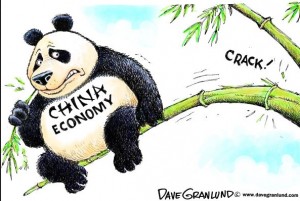Andrew Sheng and Geng Xiao write: China’s leaders are taking action to support the shift to more sustainable growth models. The finance ministry has raised the central-government budget deficit from 1.8% of GDP in 2014 to as much as 2.7% in 2015, and will allow highly leveraged local governments to swap CN¥1 trillion ($161.1 billion) of debt maturing this year for bonds with lower interest rates.
Likewise, the People’s Bank of China (PBOC) has provided monetary support, gradually lowering interest rates and reserve requirements. Because wages are still rising, the inflation target for 2015 has been set at 3% – higher than the actual 2014 inflation of 2%, even though producer-price inflation has been negative for 36 months. The PBOC also has projected a stable exchange-rate environment for this year – despite the steep depreciation of the Japanese yen, the euro, and emerging-economy currencies against the dollar – thereby promoting global stability.
These policies reflect a remarkable determination to continue on the path of structural reform, despite strong headwinds from the deteriorating external environment and domestic structural adjustments. In short, China’s government seems to have a clear long-term vision.
The claimby some that China’s economic and political development is in jeopardy seems to ignore the country’s adaptive learning process, which shapes every economic, diplomatic, military, and social policy. This process – characterized by experimentation, assessment, and adjustment – emerged from the CCP’s military experience of the 1930s, was applied by Deng Xiaoping to his reform program in the 1980s, and has been refined by subsequent Chinese leaders. Because no economy had ever experienced such rapid growth on such a large scale, the only way to manage China’s development was, as Deng put it, to “cross the river by feeling the stones.”
Some experiments have had less clear results, making, say, a positive contribution to GDP growth, but also contributing to problems like excess industrial capacity, pollution, corruption, and the creation of ghost towns. The mere fact that problems have emerged in no way suggests that China is headed for disaster; that would be the case only if these problems were allowed to persist.
China’s “new normal” needs to go beyond policies intended to sustain economic growth. Reforms must aim to bolster inclusivity, advance environmental sustainability, promote innovation, and boost competitiveness. And this is precisely the four-pronged approach that China’s leaders seem to be taking.
Indeed, from slashing coal consumption to address air pollution to plans for integrating information technologies with modern manufacturing, the government has shown time and again that it recognizes its reform imperatives. And, by remaining dogged in its efforts to root out official graft, it has demonstrated its will to do what is needed to ensure that China succeeds..
Market forces will benefit from the growth in households’ spending power. Indeed, continued real-wage growth is forcing inefficient industries that relied solely on cheap labor out of the market, while bolstering the competitiveness of producers that appeal to the evolving tastes of China’s increasingly potent consumers. To support this process, China is now implementing deposit insurance, for example.
At the same time, China is reforming its inefficient approval-based system of initial public offerings to one based on registrations. A more active and efficient IPO market will allow companies to meet their financing needs without bank intermediation – a step that is vital to helping firms eliminate their debt overhangs.
Despite the recent rebound, China’s stock-market capitalization amounts to only 40% of GDP, while banking assets total 266% of GDP. Meanwhile, only 10% of total social funding comes from the equity market.
Improved bankruptcy procedures for failed borrowers must be implemented. Unless failed borrowers and projects exit the system quickly and smoothly, the market will be saddled with bad debt and incomplete projects, undermining its performance.
China has repeatedly proved its durability and adaptability. Now, it must do so yet again, by ensuring that its “new normal” is as stable, sustainable, and inclusive as possible.
Failure may be the mother of success – but only if one makes the effort to learn from it. Fortunately, China’s leaders seem intent on doing just that.

